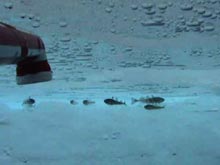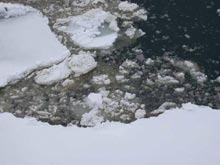
Spring pack ice cover in the Chukchi Sea. The Arctic pack ice is not a homogenous layer of ice, but consists of individual ice floes, that contain undeformed level ice and various amounts of pressure ridges. Some ridges can be deeper than 20m. Click image for larger view.
Certain layers within the sea ice can be stained by mass developments of ice algae. In the Arctic such mass developments typically occur in the bottom 10-20 cm of the ice floes. 3000m. Click image for larger view.
Arctic Sea Ice
Rolf Gradinger
Assistant Professor
University of Alaska Fairbanks
School of Fisheries and Ocean Sciences
The Arctic sea ice provides a unique set of environments for hundreds of species. Viruses, bacteria, fungi, unicellular plants and animals and metazoa are found within at the surface and at the bottom of the sea ice, several being unique (endemic) to the Arctic.
The central parts of the Arctic exhibit a year-round ice cover (so-called multi-year sea ice) while coastal and shelf locations are dominated by annual sea ice. Sea ice can freely drift with the currents (pack ice) or is attached to the coast (fast ice). Scientists distinguish dozens of different ice structures ranging from undeformed level ice to heavily ridged stamuki zones.
The organisms living within the sea ice inhabit tiny liquid filled pockets and channels between the ice crystals. This liquid (brine) does not freeze completely because of its high salt content. The size of the brine pockets and channels varies with the age and location of the sea ice but is typically less than 1mm in diameter. Consequently all organisms living within the ice need to be smaller in order to fit into these openings.
Unicelluar algae are the main primary producers in sea ice. They can occur in such high abundances that the color of the ice is no longer white/blue but instead brown/red. More than 200 algal species are known to exist in the Arctic sea ice but many species are likely not described so far. Microscopic observations on ice cores revealed that diatoms and flagellated taxa are the most important microorganisms inside the ice in terms of abundance and productivity. The plant life within the sea ice typically contributes between 2 to 50% of total plant production in the ice-covered waters of the Arctic.

Arctic cod sitting in the wedges of water along the edges of Arctic ice floes. These observations were made during Arctic Exploration 2002 and described the association of this fish species with certain topographical structures of the ice floes. Click image for larger view.
Tiny animals, mainly unicellular protozoans and a few metazoans, in particular worms and crustaceans, use the sea ice algae as their food supply. An additional unique, partially endemic fauna lives at the underside of the ice floes. As observed during Ocean Exploration 2002, these animals (mainly amphipods) move along the bottom of the ice, feed on ice algae and find shelter against predators.
The fish Arctic cod might be the most important link to marine mammals and birds. Arctic cod feed on ice amphipods and zooplankton, and hide in the gaps between blocks of sea ice and in water wedges along the edges of floes.
As the Arctic summer sea ice cover decreases substantially over time, new studies are needed to understand the role of this disappearing environment for the Arctic food web - the Ocean Exploration 2005 expedition will be an important step forward in this direction.
This expedition contributes to the Arctic Ocean Diversity project (ArcOD) ![]() of the International Census of Marine Life
of the International Census of Marine Life ![]() .
.

































